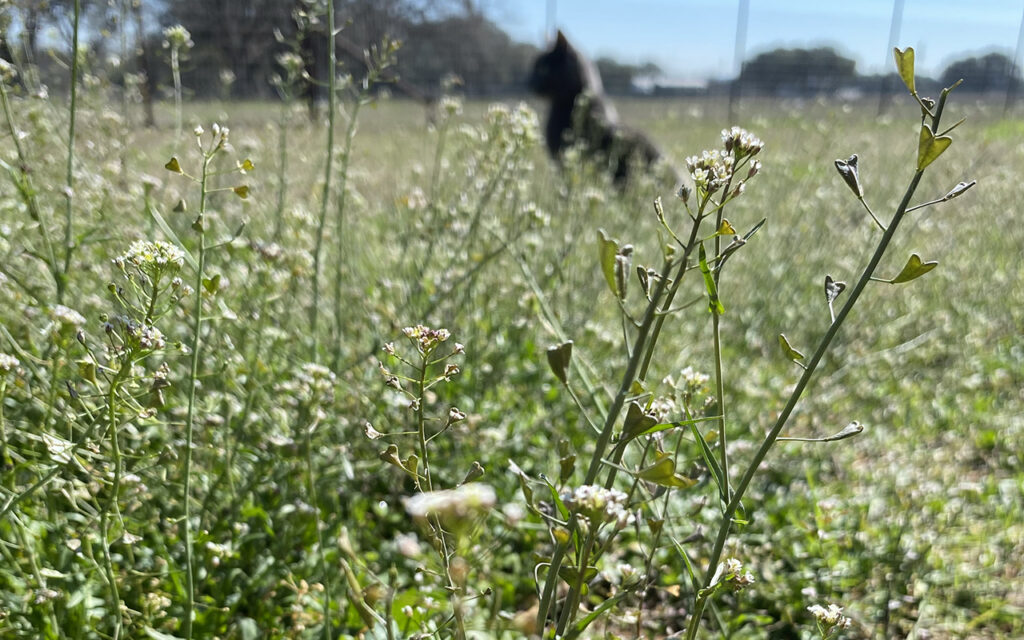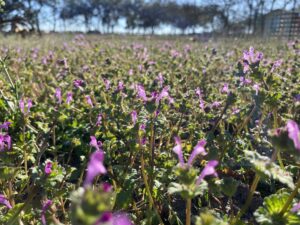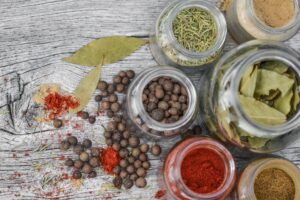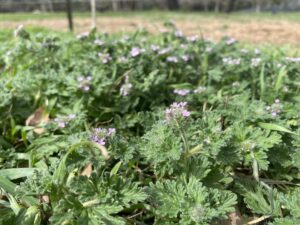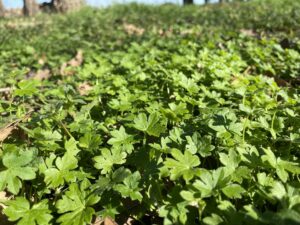Shepherd’s Purse (Capsella bursa-pastoris), is a resilient herbal ally that deserves a prime spot in your wellness toolkit. Let’s unravel the mysteries of this remarkable herb.
Where It Grows: Shepherd’s Purse is a hardy herbaceous plant that can be found across various planting zones, ranging from USDA zones 3 to 9. It favors disturbed soil in locations such as fields, roadsides, and even urban environments. This adaptable herb isn’t picky about soil types, often thriving in both sandy and loamy soils.
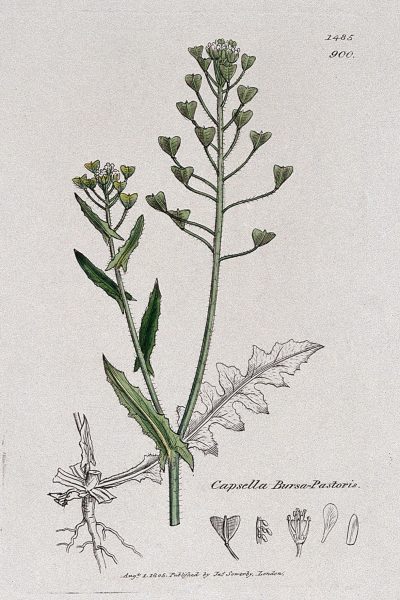
Identification: Identifying Shepherd’s Purse is a breeze once you know what to look for. Keep an eye out for its distinctive triangular seed pods, which resemble tiny purses, hence its name–though I think they look more like little hearts! The deeply lobed leaves and delicate white flowers are its signature points of recognition. While Shepherd’s Purse has few look-alike plants, it’s essential to note that young plants may resemble other members of the mustard family, so careful observation is key.
Harvesting: Timing is crucial when harvesting Shepherd’s Purse for optimal potency. Aim to gather the herb in early spring when it’s at its peak vitality. Simply snip the aerial parts—leaves, stems, and flowers—using sharp scissors or pruning shears, ensuring you choose plants from clean, unpolluted areas.
Ethical harvesting leaves plenty of plants behind so they can reseed and return year after year for your benefit. The herb patch shouldn’t look much different than when you began. For optimal regrowth, snip stems at least two inches above the ground, and above a node. Remove only one-third of the leaves on the basal rosettes.
Nutrient Profile: Rich in vitamins and minerals, including vitamins A, C, and K, as well as calcium, potassium, and iron, Shepherd’s Purse offers a bounty of health-promoting properties. Its leaves and seeds are particularly noteworthy, containing compounds such as flavonoids and alkaloids that contribute to its medicinal benefits.
Contraindications: While generally safe for most individuals, those with a history of kidney issues should use Shepherd’s Purse cautiously due to its diuretic effects. Pregnant or nursing individuals should seek guidance from a healthcare professional before incorporating Shepherd’s Purse into their regimen.
Preparing Shepherd’s Purse: Once you’ve gathered your Shepherd’s Purse bounty, give it a gentle rinse to wash away any lingering impurities if needed–if you are harvesting carefully from a quality source this step should not be needed. Then, it’s time to dry. Hang it upside down in a well-ventilated area away from direct sunlight, or opt for a low-heat dehydrator for quicker results. We use the 9-Tray, 600W Excalibur Dehydrator.
Store the dried herb in a cool, dark place, preserving its potency for future use. We keep our in mason jars, protected from the sunlight inside cabinets.
Edible & Medicinal Parts: Both the leaves and flowering tops of Shepherd’s Purse are edible and medicinal. The young leaves add a nutritious punch to salads and stir-fries, while the flowers can be used as a garnish. Medicinally, Shepherd’s Purse is prized for its ability to regulate menstrual flow, support urinary health, and promote wound healing.
Culinary Preparations:
- Shepherd’s Purse Salad:
- Ingredients:
- Fresh Shepherd’s Purse leaves and flowers
- Mixed salad greens
- Cherry tomatoes
- Cucumber, thinly sliced
- Red onion, thinly sliced
- Feta cheese, crumbled (optional)
- Dressing:
- Olive oil
- Lemon juice
- Salt and pepper to taste
- Directions:
- Rinse and dry the Shepherd’s Purse leaves and mixed salad greens.
- Combine all salad ingredients in a large bowl.
- In a small bowl, whisk together olive oil, lemon juice, salt, and pepper to make the dressing.
- Drizzle the dressing over the salad and toss gently to coat. Serve immediately.
- Ingredients:
- Shepherd’s Purse Omelet:
- Ingredients:
- Fresh Shepherd’s Purse leaves
- Eggs
- Milk or water
- Salt and pepper to taste
- Grated cheese (optional)
- Directions:
- Rinse and chop the Shepherd’s Purse leaves.
- In a bowl, beat eggs with milk or water, salt, and pepper.
- Heat a non-stick skillet over medium heat and pour in the egg mixture.
- Sprinkle chopped Shepherd’s Purse leaves (and grated cheese if using) over the eggs.
- Cook until the omelet is set and lightly golden on the bottom, then fold it over and cook for another minute or until cooked through. Serve hot.
- Ingredients:
Harnessing Shepherd’s Purse’s Healing Powers: Shepherd’s Purse is a versatile herb with a myriad of medicinal benefits. Here’s how you can incorporate it into your holistic wellness routine:
- Menstrual Harmony: Say goodbye to menstrual woes with Shepherd’s Purse. Brew a nourishing tea by steeping dried leaves, stems, and flowers in hot water for a soothing elixir that helps regulate menstrual flow and ease discomfort.
- Urinary Vitality: Keep your urinary system in check with Shepherd’s Purse. Enjoy a refreshing cup of tea to support kidney function and promote urinary tract health, thanks to its gentle diuretic properties.
- Wound Whisperer: Shepherd’s Purse is a staunch ally in the battle against minor cuts and bruises. Create a healing poultice by blending dried leaves into a fine powder and mixing it with water. Apply this paste to wounds for accelerated healing and relief.
Medicinal Preparations:
- Shepherd’s Purse Tea Infusion:
- Ingredients:
- Dried Shepherd’s Purse leaves, stems, and flowers
- Water
- Directions:
- Boil water in a saucepan or a kettle.
- Place dried Shepherd’s Purse leaves in a teapot or heatproof container like a mason jar.
- Pour the boiling water over the leaves.
- Cover and let steep for 4 hours.
- Strain the tea and enjoy hot or cold within 24 hours. Add honey or lemon for flavor if desired.
- Ingredients:
- Shepherd’s Purse Poultice:
- Ingredients:
- Dried Shepherd’s Purse leaves, stems, and flowers
- Water
- Directions:
- Grind dried Shepherd’s Purse parts into a fine powder using a mortar and pestle, coffee grinder, or herb grinder.
- Mix the powdered herb with enough water to form a thick paste.
- Apply the paste directly to wounds, cuts, or bruises.
- Cover with a clean bandage and leave on for 20-30 minutes.
- Rinse off with warm water and pat dry. Apply as needed for relief.
- Ingredients:
Disclaimer
According to the FDA, only medical professionals can give medical advice. Neither Julie nor Neil are “medical professionals” or “qualified health providers.” We believe in educating ourselves and our community on holistic alternatives to allopathic medicine. As such, the FDA legally restricts the language we can use as citizens and business owners in the United States of America.
The information provided in this article is for educational purposes only and is not intended as a substitute for professional advice, diagnosis, or treatment. Always seek the advice of a qualified health provider with any questions you may have regarding a medical condition. Never disregard professional advice or delay in seeking it because of something you have read in this article. The use of any information provided in this article is solely at your own risk.
